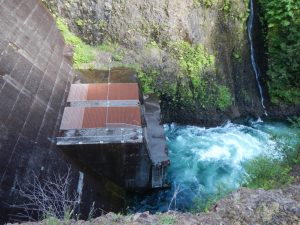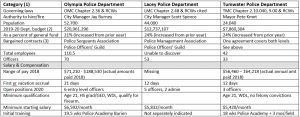The era of dam building is over for a reason. Take the Wynoochee River, a tributary of the Chehalis River. The US Army Corps of Engineers dammed it in 1970. The government promised that the dam would “improve river conditions” for salmon during hot summers. Instead, runs of wild salmon have been decimated and the character of the river has been drastically altered.

We must remember the lesson of the Wynoochee as the Washington State Department of Ecology compiles and responds to the 5,000 comments it received on the Draft Environmental Impact Statement (EIS) for the Proposed Chehalis River Basin Flood Damage Reduction Project, or dam. The Chehalis Basin Board will review Ecology’s comprehensive analysis of the comments at its upcoming July meeting. Within the next year, a final EIS will be issued. This fall, the U.S. Army Corps of Engineers will release a National Environmental Policy Act draft (NEPA). As the debate rages over constructing a dam on the Chehalis, there is much to learn from mistakes of the past.
Exploiting a dynamic river
The headwaters of the Wynoochee River are in the Olympic mountains. One of the larger tributaries of the Chehalis River, the Wynoochee is about 60 miles long and joins the Chehalis River between Montesano and Aberdeen. Wynoochee means /xʷənúɬ/ or “shifting” in the Lower Chehalis language.”
While it may not be apparent, flooding is essential to a healthy river, especially here in the Pacific Northwest.
The Wynoochee Dam sits on the upper Wynoochee River about 52 miles upstream of the Chehalis confluence. Engineers designed the dam to control flooding and to increase the reliable supply of water for current and planned industrial uses. In addition to supplying water for two large pulp and paper mills in Aberdeen and Hoquiam, stored water would replace the Chehalis River water withdrawn from the now defunct Satsop nuclear plant.
One of the paper mills, ITT Rayonier/International Paper Company, closed all operations in 1992 and never reopened. The other—Weyerhauser Company, shut down in 2005. Six years later, a private equity firm, purchased the former Weyerhaeuser Mill and opened Cosmo Specialty Fibers. Citing a decline in product demand brought about by COVID-19 and other reasons, Cosmo temporarily shut down all operations in April 2020.
In 1994, Tacoma Power built a powerhouse immediately downstream from the dam. The powerhouse generates enough energy to serve a mere 2,100 homes. The Wynoochee Dam has not been a financial win for its owner, the City of Aberdeen. “Aberdeen requested government assistance to prevent bankruptcy from losses due to the dam.
Impact on Salmon
The Wynoochee offers a lesson. The industrial projects it was built for are gone, it generates little electricity. It did not improve the environment for salmon during water releases. in times of low flow. Wild salmon populations in this river have significantly declined since the dam’s completion.
The area that is now Lake Wynoochee was an important spawning area for Chinook salmon. They are gone. Instead of improving conditions, the dam blocked 12 miles of excellent mainstem habitat and even more high-quality habitat in the tributaries above the dam. Before the dam, the tributaries and upper 12 miles of river were refugia of cold water—water that could be vital in the face of climate change. Now this water is way too warm, affecting water quality above and below the dam.
The dam contains no fish passage facilities. Adult wild Coho and Steelhead going upstream pass the Wynoochee Dam through a trap and haul operation. The few adult wild Chinook salmon are not transported. Downstream juvenile fish passage is allowed during a 45-day run-of-the-river operation each spring when no turbines operate. Juveniles must survive a 175-foot plunge from the reservoir surface into the river below. Mortality rates from this plunge vary from 14% to 60%.
Benefits of natural flow and flooding
All dams alter the hydrograph (flow regime) of rivers, which impacts the habitats and character of the river for miles downstream. Wild fish populations that were locally adapted to conditions in the Wynoochee have had to adapt to the new conditions, or perish. Wood, essential for habitat and structure, cannot pass over the dam. Furthermore, a section of the river downstream of the dam is starved of gravel, which is necessary for spawning grounds. While it may not be apparent, flooding is essential to a healthy river, especially here in the Pacific Northwest. In addition to delivering wood, the high water moves, sorts, and distributes the gravel required for spawning. High water creates and maintains deep pools and healthy side channels that are juvenile fish nurseries. High water sustains wetlands, recharges groundwater, maintains riparian stream-side forests, and so much more.
Have we learned the lesson?
Above the dam and lake, the upper Wynoochee River is still a river. Here is our lesson: there are deep pools and gravel distributed by high flows, and there are giant logs delivered by storms and floods. This is what a river should look like. Rivers teach us, again and again. Dams kill rivers. The good news is it’s not too late for the Chehalis.
Lee First is a Twin Harbors Waterkeeper.

My uncle Joe Malinowski found the dam site in about 1920 hiking from the family farm on the Wishkah River. He was the son of Polish immigrants with a third grade education. He filed for and recieved the water and power rights for the site in 1922. Development of the site became a battle between the local private power company and public power advocates. Joe donated his rights to the City of Aberdeen for $1 after the private company offered him $50,000. Our family is proud of Joe’s role in development of the project,
I am a member of Fish First and the Coastal Conservation Association and have managed salmon habitat restoration projects. Both groups are convinced the evidence shows that high salmon harvest rates are the primary cause of salmon decline. Dams don’t help but salmon populations in undamed streams are just as deminished as those in damed streams with fish passage. We should be focusing on the major cause of salmon decline and quit advocating for removal of dams that have many benefits for the NW.